Despite decades of awareness, AIDS misinformation continues to spread, often undermining public health and stigmatizing those affected. In 2025, many myths persist, leaving people confused and misinformed. Why do these falsehoods still exist, and what can we do to correct them?
Table of Contents
- Common Myths About AIDS
- Why Misinformation Persists
- The Role of Social Media
- How to Recognize and Fight False Claims
- Conclusion
- FAQ
Common Myths About AIDS
One of the most common myths is that AIDS can be transmitted through casual contact like hugging or sharing utensils. Others believe AIDS is only a concern for specific groups, which is completely false. AIDS can affect anyone, regardless of gender, race, or sexual orientation.
Some even think there’s no treatment or that HIV always leads to AIDS. However, with proper medical care, people living with HIV can manage the virus effectively and never develop AIDS.
Why Misinformation Persists
Misinformation thrives when education and access to accurate information are lacking. Cultural taboos and stigmas also prevent open conversations about HIV and AIDS. In many communities, outdated beliefs are passed down and rarely challenged.
In contrast, improved access to treatment and awareness campaigns have made a difference, yet more needs to be done to reach everyone equally.
The Role of Social Media
Social media can be both helpful and harmful. While it spreads awareness quickly, it also allows false information to go viral. In some cases, influencers or online personalities share unverified claims that can mislead thousands of followers in minutes.
It’s crucial to follow reputable health sources and fact-check any suspicious health advice or claims.
How to Recognize and Fight False Claims
Look for information from trusted health organizations like the CDC or World Health Organization. They offer up-to-date, evidence-based facts. Be wary of sensational headlines, especially those that promise “cures” or use fear to grab attention.
Engaging in respectful dialogue and sharing correct information helps dismantle stigma and bring clarity to important health conversations.
Conclusion
Addressing AIDS misinformation in 2025 is more important than ever. Myths fuel stigma and prevent people from seeking help or learning the facts. By challenging falsehoods and promoting accurate knowledge, we can create a more informed and compassionate world.
FAQ
Can you get AIDS from touching someone?
No. AIDS cannot be transmitted through touch, hugging, or casual contact.
Is there a cure for AIDS?
No cure exists yet, but effective treatments allow people with HIV to live long and healthy lives.
Does everyone with HIV develop AIDS?
No. With proper treatment, many people living with HIV never develop AIDS.
Where can I get accurate AIDS information?
Visit reputable health sites like CDC or talk to a certified healthcare provider.
Why do people still believe myths in 2025?
Stigma, lack of education, and the spread of false information on social media continue to contribute to these beliefs.
This content is not medical advice. For any health issues, always consult a healthcare professional. In an emergency, call 911 or your local emergency services.




